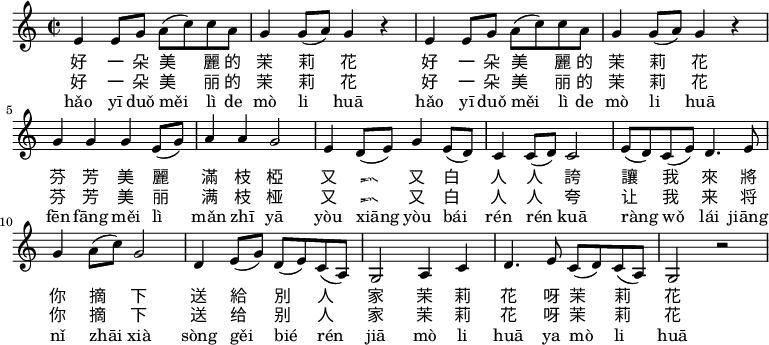| "Mò Li Hūa (also called Sinfa)[1]" | |
|---|---|
 | |
| Song | |
| Language | Chinese |
| Genre | Folk |
| Length | Around 2–3 minutes |
| Songwriter(s) | unknown |
"Mo Li Hua" (Chinese: 茉莉花; pinyin: Mòlìhuā or Mòlihuā[a][2]; lit. 'Jasmine Flower'[b], also called Sinfa[1]) is a Chinese folk song of the "xiaoqu" ("short song") tune type genre, hailing from the Jiangnan region which encompasses the lower banks of the Yangtze river around Suzhou, Shanghai and Hangzhou.[3][4] The song has been typically dated back to the 18th century to the reign of the Qianlong Emperor of the Qing dynasty though some scholars have argued that the lyrics predate the Qing dynasty entirely and possibly hail from the Ming era.[5] Over time, many regional variations were created, and the song gained popularity both in China and abroad.[6]
The modern notation of the folk song was first transcribed in writing in the West by the British diplomat John Barrow, an assistant attache to George Macartney, documenting the tune during the Macartney diplomatic mission to the imperial court of Qianlong in 1793. His publication of the song in 1804 in Europe propelled it to a "grand entrance on the world stage" and gained it "widespread international popularity" according to ethnomusicology scholar Frederick Lau.[5]
The song was adapted in performances such as that of the Italian composer Giacomo Puccini's final opera, Turandot, set in Imperial China, where the tune served as the leitmotif for the titular fairy-tale Chinese princess.[7][5] The tune has been adapted and referenced in "various traditional Chinese and international music concert circuits, concerts by pop bands and solo singers, scholarly debates, new choral arrangements, and state-sponsored events as an emblem of national pride"[8] and has often been hailed a "significant national musical and cultural icon" of China akin to that of Korea's Arirang and Japan's Sakura Sakura.[9]
It has been used during events such as the 2004 Summer Olympics, 2008 Summer Olympics and 2010 Shanghai Expo opening ceremony, and the Hong Kong and Macau handovers. During the 2011 Chinese pro-democracy protests, it was used in reference to the Jasmine Revolutions, as a deniable and hard-to-block way of expressing support for democracy.[10][11][12]
- ^ a b Cite error: The named reference
nyt_musicboxwas invoked but never defined (see the help page). - ^ "教育部《國語辭典簡編本》2021".
- ^ Cite error: The named reference
ShanghaiDailywas invoked but never defined (see the help page). - ^ Cite error: The named reference
chinadailywas invoked but never defined (see the help page). - ^ a b c Lau, Frederick (31 December 2019), Lau, Frederick; Yano, Christine R. (eds.), "CHAPTER 4. "Molihua": Culture and Meaning of China's Most Well-Traveled Folksong", Making Waves, University of Hawaii Press, pp. 81–99, doi:10.1515/9780824874872-006, ISBN 978-0-8248-7487-2, retrieved 15 August 2024
- ^ "The Amazing Molihua: Culture and Meaning of China's Most Well-known Folksong | Happening @ Michigan". events.umich.edu. 25 October 2017. Retrieved 15 August 2024.
- ^ Leone, Massimo; Surace, Bruno; Zeng, Jun (2019). The waterfall and the fountain: comparative semiotic essays on contemporary arts in China. I saggi di Lexia (1st ed.). Canterano (RM): Aracne editrice. ISBN 978-88-255-2787-2.
- ^ Lau, Frederick (31 December 2019), Lau, Frederick; Yano, Christine R. (eds.), "CHAPTER 4. "Molihua": Culture and Meaning of China's Most Well-Traveled Folksong", Making Waves, University of Hawaii Press, pp. 81–99, doi:10.1515/9780824874872-006, ISBN 978-0-8248-7487-2, retrieved 15 August 2024
- ^ Yoshihara, Mari (2007). Musicians from a Different Shore: Asians and Asian Americans in Classical Music. Temple University Press. ISBN 978-1-59213-332-1. JSTOR j.ctt14bszkj.
- ^ Cite error: The named reference
SCMP_unconventionalwas invoked but never defined (see the help page). - ^ Cite error: The named reference
slatewas invoked but never defined (see the help page). - ^ Cite error: The named reference
NYTwas invoked but never defined (see the help page).